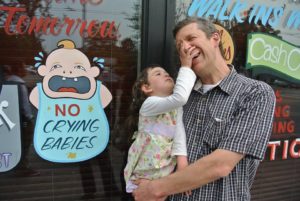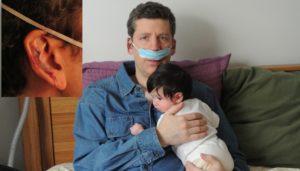I had my first nasal surgery in 2006 and it was basically the end of life as I knew it. It divided my life into “before” surgery and “after” surgery. When my nose opened up after my first surgery and I took my first big deep breath (with my “new” nose) I noticed right away that I didn’t feel anything. I thought it was odd. I figured I was still just sore from surgery but over time I basically forgot what it was like to breathe. I started to slowly lose my reference for what “normal” even was but something was surely lost and it never came back.
These are my parents below. We all come from somewhere and most start life somewhat lucky and equal with arms, legs, eyes etc. I still often look back and think that I started off “OK”. They gave me everything and I messed up my life by trusting ENT doctors. I have excellent genes with long life and good health on both sides of my family. All of my brothers and sisters are fine and I used to run up mountains with ease.

As things got worse later in years I spent hours a day at work day dreaming about my previous life, even things like how the sun would shine in the windows in my 3rd grade Art class. I spent a lot of time living in the past each day because my present life was unbearable.There was no break from it. The pressure of having to perform at work and provide for my family while feeling sick every day was starting to weigh on me. In my business there are “Lay-offs” every year and I was “competing” with coworkers who had nasal turbinates and who actually slept at night.
By 2016 ENS had “consumed” 10 years of my life. It had tainted stained and ruined nearly every aspect of my recent life from my wedding to the birth of my child to simply even trying to relax and watch a movie. It only bothers me when I breathe. The average person breaths 16 times per minute and at 23,000 breaths per day there is no break day or night. Every breath was “wrong” and often times painful. I was out of breath even reading a children’s book to my daughter laying in bed. I would lift her on up onto a sliding board 2 or 3 times and be done. Of course she wanted more, but I couldn’t even do it. She deserved a father who wasn’t a nasal cripple.Here she is (below) trying to fix my nose herself. 
Below: Just after getting my first real help. “Partial repair” (cartilage grafts) Here is what you look like after having all the cartilage cut out of your right ear and stuffed into your nose where your turbinates used to be:

Deciding to have a child was a real issue for us. A year before her birth I was at a real low point. I carried saline sprayers with me everywhere (note one in pocket in picture above) and if I forgot one for even a brief time, it was painful. I was getting up 3-4 times a night. Each morning when I awoke it was like I had been kicked and beaten. I would have to sit up in bed for 20 minutes to “recover” from sleep before I could stand up yet I had to go to work regardless of how sick I felt.
I went to work tired every day. I was yawning constantly in meetings which makes you look real interested in what your boss has to say. I found it impossible to concentrate anyway with nerve pains shooting toward my left eye and radiating into my brain causing nasty migrain headaches. I had near constant feelings of suffocation and panic with very low energy levels. Luckily for me I worked in a lab by myself most of the time so I could have wet tissue paper sticking out of my nose without others seeing me that way. When I had meetings I took my prosthetic clips and tissue paper out of my nose. I would try not to spray saline so often so no one would wonder what I was doing. Without constant spraying I was dry in 5 minutes and in pain after about 15 minutes. I tried breathing through my mouth but my lungs were also beginning to hurt. Meetings were hell. I tried to stay away from coworkers. I went home tired and the whole thing started over again every day.
In 2011, I tried taking a nap one day and when I woke up I was so weak this time that I fell on the ground and couldn’t stand up. I had my wife take me to the emergency room and told them to “FIND IT”! They ran all kinds of tests and all they could tell me was that I had extreme exhaustion. All tests were normal. I then had neurology tests and extensive heart tests. Everything was fine. ENS is an insidious problem that turns your own nervous system against you. You are constantly engaged. Your muscles are tense and you wear yourself out with no chance to sleep.
My daughter helped to keep me focused on getting help. In 2012 I was finally “officially” diagnosed with ENS by a good doctor who was also a “great man”. He unabashedly wrote in his notes that I was a “Nasal Cripple” and described what was done to me in very blunt direct terms. He said my heads were “Amputated” an described me as “Over Opened”. He wrote that my tissue was sclerotic. He offered and inserted some cartilage grafts which helped me a lot but it was not a complete fix. He was not able to get larger silicon shims into my tissue where he wanted. He still helped me a lot and he even wrote off most of the bill. He helped me a lot spiritually to finally have a doctor be straight and honest with me for the first time. He shared his feelings regarding nasal surgery and ENS. He was dismayed at some things that go on in his profession. I had encountered a WALL of denial and his condor was refreshing. His gift of compassion and great care was uplifting just to think about every day and has stayed with me.
I started reading as much as I could. I saw a lot of CFD aerodynamics studies and when I finally read Dr. Marc Oliver Scheithauer’s excellent study called “Surgery of the Turbinates and Empty Nose Syndrome” things finally made complete sense to me regarding what I was experiencing. I started a long journey seeking answers and help which took me all over the country to see many more specialists. Eventually, I realized that since I worked in engineering and had access to modeling software that I could probably study my own case of ENS to perhaps help myself and others concerning the placement of implants during reconstructive surgery.
I finally found excellent help at Stanford University and getting nasal implants enabled me to regain a sizable portion of my life. I am passing along a lot of the information I learned and I hope this helps others and moves the understanding of this issue forward.
